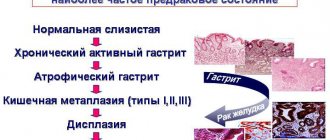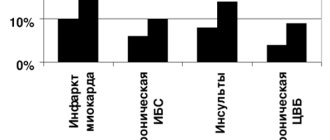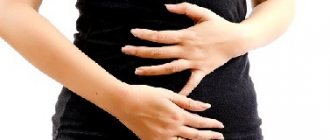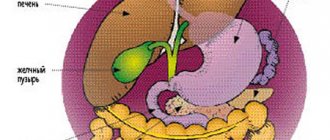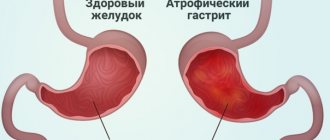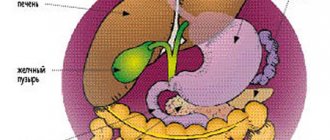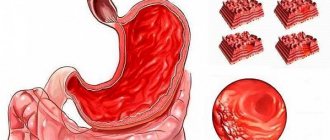- Outpatient department
Outpatient department » - Gastroenterology
Gastroenterology »
- About the direction
About the direction »
- Gastritis: symptoms, diagnosis and treatment
Gastritis is perhaps the most common disease of the gastrointestinal tract. Almost every second resident of our country suffers from it. That is why it is so important to know the first signs and symptoms of this disease in order to start treatment on time and not neglect your health.
Gastritis (from the Latin gastritis, from the ancient Greek γαστήρ (gaster) - “stomach” + -itis inflammatory or inflammatory-dystrophic changes in the mucous membrane) is a collective concept that is used to refer to various inflammatory and dystrophic changes in the gastric mucosa. Damage to the mucous membrane can be primary, considered as an independent disease, caused by poor nutrition, and secondary, caused by other infectious and non-infectious diseases or intoxication.
Types of gastritis
Acute gastritis
In modern medicine, there are several types of acute gastritis:
Simple (catarrhal) gastritis develops as a result of ingestion of stale food contaminated with pathogenic microbes (foodborne toxic infection), rotavirosis, allergies, or as a result of damage to the gastric mucosa by medications. With catarrhal gastritis, the surface layer of the mucous membrane is destroyed, which is quickly restored after the cessation of the irritating factor.
Corrosive (erosive) gastritis. This type of gastritis develops after concentrated acids or alkalis enter the stomach, which corrode the gastric mucosa. In this case, not only the superficial, but also the deep layers of the gastric mucosa are destroyed, so this form of the disease often gives rise to peptic ulcers or the formation of scars.
Phlegmonous gastritis is a purulent inflammation of the stomach that can develop as a result of penetration of a foreign object (for example, a fish bone) into the stomach wall with subsequent infection of this area. A distinctive feature of this type of gastritis is high fever and unbearable pain in the epigastric region. Phlegmonous gastritis requires immediate surgical intervention, as it can develop into peritonitis (extensive inflammation of the abdominal organs) and be fatal.
Fibrinous gastritis. It occurs very rarely against the background of sepsis (blood poisoning).
With proper treatment, acute gastritis (depending on the form) lasts up to 5 - 7 days, but complete recovery of the stomach occurs much later.
Often acute gastritis can become chronic.
Chronic gastritis
Chronic gastritis can develop as a consequence of acute gastritis or as an independent disease. Its danger lies in the fact that it can occur for a long time without showing any symptoms.
In the development of the disease, as a rule, there are periods of exacerbation and remission. During periods of exacerbation of chronic gastritis, short-term attacks of pain, discomfort in the upper abdomen, a feeling of heaviness, nausea after eating, and heartburn may appear, which indicates a dysfunction of the natural “valves” of the stomach and the reflux of acidic stomach contents into the esophagus.
A characteristic feature of chronic gastritis is the gradual growth of connective tissue in the gastric mucosa, replacing the cells that produce gastric juice (atrophy of the gastric mucosa). Chronic gastritis is often accompanied by a decrease in the production of gastric juice and acid (hypoacid gastritis).
Helicobacter pylori infection, which parasitizes the stomach, disrupts the renewal processes of the mucous membrane; thus, when old cells die, new ones cannot be formed. This leads to gradual degradation of the gastric mucosa with loss of function of the glands that produce gastric juice.
Diso Nutrimoon
Protein for treatment and rehabilitation
An easily digestible, tasteless protein mixture, a source of proteins and amino acids necessary for the body to fight illness, recover from injuries, illnesses and operations.
More details
Diso Nutrimun can be consumed not only by adults, but also by children over 3 years old, pregnant and nursing mothers - it is a safe and healthy food product. And besides, it is easy to use: it does not lose its nutritional properties after heat treatment, can be stored for a long time, and is easy to stir.
Causes of gastritis
The main causes of gastritis are:
- poor nutrition;
- hasty eating and poorly chewed food or dry food;
- eating food that is too hot or too cold;
- eating savory foods (mostly spicy and highly salted);
- smoking;
- alcohol consumption;
- stress;
- infection with the microbe Helicobacter pylori;
- chewing gum on an empty stomach.
Consequences and complications
- Chronic blood loss. Erosive lesions of the mucous membrane are accompanied by bleeding and occupy third place among its causes. Erosive gastritis in 65% of patients is accompanied by chronic blood loss and iron deficiency anemia .
- Acute hemorrhagic gastropathy. Acute bleeding from erosions is caused by various factors. This may be alcohol intake, exposure to uremic toxins, the patient having sepsis , polytrauma , shock , burns or ischemia .
- If Helicobacter pylori infection is not treated in a timely manner, there is a risk of developing mucosal atrophy, which is accompanied by a risk of developing cancer.
Symptoms of gastritis
So, how can you recognize that you have begun to develop gastritis? It is worth listening to your body and analyzing why pain bothers you, at what time it occurs and how often it happens.
Symptoms of gastritis:
- abdominal pain: sharp paroxysmal or constant painful;
- nausea is constant or intermittent, often occurring immediately after eating;
- heartburn;
- belching with a sour smell;
- repeated vomiting (in the case of acute gastritis, vomiting with blood is possible, since internal bleeding may open in the stomach);
- increased salivation;
- sometimes dry mouth;
- bowel dysfunction: constipation or diarrhea;
- from the whole body: severe general weakness, dizziness, headache, sweating, increased temperature, decreased blood pressure, increased heart rate - tachycardia;
- decreased appetite;
- unpleasant taste in the mouth;
- feeling of heaviness in the stomach after eating;
- bloating, rumbling in the stomach, flatulence;
- anemia, brittle and dry hair, split nails.
Classification
The classification is based on the following characteristics:
- By type of gastric erosion: acute (2-7 days); chronic erosion (30 days or more).
- By number: single (1-3) and multiple (3 or more).
- According to the localization of erosions: at the fundus of the stomach, in the antrum, in the area of the body of the stomach.
- According to histological characteristics: flat (superficial), full (mature/immature) and hemorrhagic.
- By the nature of occurrence: a self-occurring form (primary) and as a complication of various diseases (secondary).
- According to the phases of the course: acute phase, fibrinous phase; epithelialization phase; phase of clinical and anatomical remission.
- According to the course of the disease: acute - duration (10-60 days) and chronic (from 2 months to several years).
- According to histological structure: superficial (flat), hemorrhagic, complete (immature and mature).
Diagnosis of gastritis
Today, the main way to determine gastritis is fibrogastroduodenoendoscopy or FGDS, which consists of studying the condition of the inner surface of the stomach using a probe, as well as a biopsy - removing a small fragment of tissue for examination.
FGDS makes it possible not to confuse gastritis and ulcer and to determine the type of disease: erosive or non-erosive.
Also, a gastroenterologist, to make a correct diagnosis, may prescribe the following tests:
- General blood analysis.
- Fecal occult blood test.
- Histological examination of a biopsy specimen of the gastric mucosa.
- Cytological examination of a biopsy specimen of the gastric mucosa.
- Two tests for the determination of H. pylori.
- Blood chemistry.
- General urine analysis.
Prevention
- Normalization of work and rest schedules. Rational dietary nutrition.
- If it is necessary to take ulcerogenic drugs, they should be taken only in combination with proton pump inhibitors, antacids or gastroprotectors.
- Timely treatment of concomitant diseases ( coronary disease , hypertension , chronic hepatitis , biliary dyskinesia , cholecystitis , cirrhosis , chronic pancreatitis ).
- Carrying out eradication treatment. During the inter-relapse period, sanatorium-resort treatment using mineral waters of low and medium mineralization is indicated.
- To prevent relapses in the autumn-spring period, carry out anti-relapse treatment for 3 weeks. Antacids and enveloping drugs are prescribed.
- Patients with frequent relapses of the disease (2 or more times a year) require constant monitoring.
Endoscopic examinations should be performed 6 and 12 months after the last relapse.
Considering that acute stress erosions develop after operations, it is important after surgery to correct electrolyte disturbances, normalize the coagulation system and control the pH of gastric contents. At risk are patients with sepsis, burns, shock or central nervous system injury. Such patients should receive preventive treatment (antacids, proton pump inhibitors, alkaline drinking).
Diet for gastritis
For gastritis with low acidity
Can:
- boiled lean meat: chicken, rabbit;
- meat broths;
- lean fish: pink salmon, hake, cod;
- vegetables in the form of puree or grated: carrots, potatoes, green peas, beets;
- ground fruits, compotes and jelly from apples, raspberries and strawberries;
- porridge (oatmeal, semolina, rice);
- low-fat cottage cheese, milk;
- only squeezed cabbage juice;
- alkaline mineral waters, for example Borjomi (1 glass an hour before meals).
It is forbidden:
- hot and spicy dishes;
- canned food;
- mustard;
- pepper;
- onion;
- hot sauces.
For gastritis with high acidity
Can:
- pureed vegetarian soups;
- dairy products;
- lean fish and boiled meat;
- scrambled eggs;
- porridge, jelly, jelly;
- vegetable purees;
- compotes from fresh (not sour) fruits;
- carrot juice;
- White bread.
It is forbidden:
- coffee and strong tea;
- meat broths;
- smoked meats;
- mustard;
- onion;
- garlic.
For all types of gastritis, split meals are very important - 5-6 times a day.
Gastritis (from the Latin gastritis, from the ancient Greek γαστήρ (gaster) - “stomach” + -itis inflammatory or inflammatory-dystrophic changes in the mucous membrane) is a collective concept used to refer to inflammatory and dystrophic changes in the gastric mucosa of different origins and course. Damage to the mucous membrane can be primary, considered as an independent disease (due to poor nutrition), and secondary, caused by other infectious and non-infectious diseases or intoxication.
Gastritis is perhaps the most common disease of the gastrointestinal tract. Almost every second resident of our country suffers from it.
If you are really looking for your doctor...
Treatment approaches
Drug treatment includes long-term use of antisecretory drugs that provide a persistent increase in acidity in the stomach, which is necessary for rapid healing of erosions. For emergency treatment of bleeding, methods of surgical hemostasis (vessel clipping or electrocoagulation) are used.
Correction of water and electrolyte balance is carried out using infusion of crystalline and colloidal solutions.
Adequate treatment of the disease is impossible without prescribing a diet. The menu for erosive gastritis should consist of lean meats and fish, boiled or baked, cereals, stewed vegetables, and soups. Patients are advised to limit the consumption of fresh fruits and vegetables, meat broths, and yeast dough products as much as possible.
The prognosis is relatively favorable; with timely initiation of therapy, recovery occurs in most patients.
List of sources
- Nikiforov P. A. et al. Diagnosis and follow-up of chronic erosions of the antrum of the stomach // Kremlin Medicine. Clinical Bulletin. – 2008. – No. 4. – P. 61-64.
- Belova E.V. Characteristics of aggressive-protective factors in erosions of the gastroduodenal mucosa / EB Belova, Ya.M. Vakhrushev // Therapist. archive. 2002. - No. 2- P. 17-20.
- Mosina, L. M. Some pathogenetic mechanisms of erosive and ulcerative lesions of the gastroduodenal zone / L. M. Mosina, L. V. Matveeva, E. A. Mitina // International Journal of Experimental Education. – 2011. – No. 7. – P. 40-42
- Svinitsky, A. S. Stomach erosions: issues of pathogenesis, clinical picture, diagnosis and treatment / A. S. Svinitsky, G. A. Solovyova // Clinical medicine. – 2008. – T. 86, No. 9. – P. 18-24.
- Maev I.V. Chronic gastric erosions: mechanisms of etiopathogenesis and new approaches to treatment // Clinical perspectives of gastroenterology and hepatology. - 2002. - No. 2. - P. 15-20.

